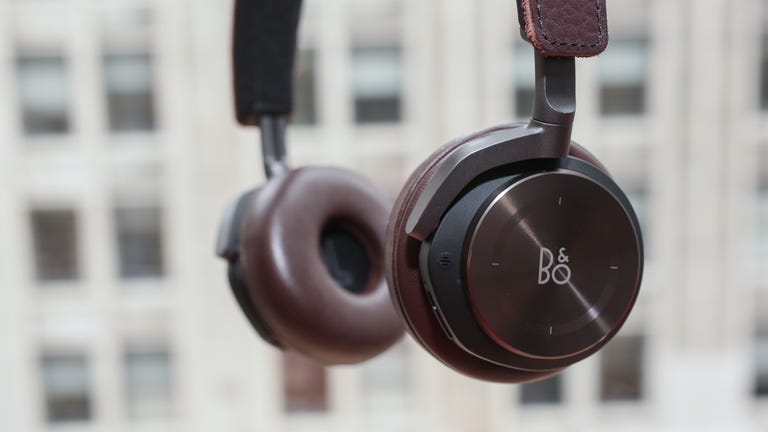 Why You Can Trust CNET
Why You Can Trust CNET Bang & Olufsen BeoPlay H8 review: A swanky Bluetooth headphone with a price to match
This $500 wireless on-ear headphone looks great and is loaded with features, including noise canceling, but a few small flaws take away some of its luster.
The Bang & Olufsen BeoPlay H8 is a wireless Bluetooth headphone that also features noise canceling. As you might expect from a B&O product, the H8 is beautifully designed with a sturdy metal and leather headband and plush sheepskin earcups that are equipped with memory foam. It's also expensive, costing $500 (£400 UK, AU $679), which is definitely at the high-end of the Bluetooth headphone spectrum, particularly for an on-ear model.
The Good
The Bad
The Bottom Line
There's a lot to like about the H8, but it also has a few small flaws that take away some of its luster.
Let's start with the good. It's relatively compact, weighing 255 grams, looks good on your head, and is also comfortable for an on-ear model. I also appreciated that the rechargeable battery, which is rated for an ample 14 hours of music playback with Bluetooth and noise canceling on, is removable and replaceable.
The earcups are built from anodised aluminium with a sheepskin pad that's ultrasoft but will steam up your ears in warmer environments. The outside of the right cup is a touch interface, with simple gesture controls to to answer calls, adjust volume and change songs. The touch controls work well, though you can end up accidentally pausing or playing your music when removing the headphones.
Additional features include AptX, a technology that's available in certain smartphones (Samsung Galaxy models, for example, but not iPhones) and is designed to improve the sound quality of Bluetooth streaming. There's some debate over how much of a difference it makes, but some people swear it does improve sound quality.
As for accessories, you get a thick cloth carrying pouch (it's decent enough, but you'd think a $500 headphone might come with a true carrying case) and a cable for listening to the headphone in wired mode. That cable may come in handy should a flight attendant inform you that you can't use Bluetooth headphones while in the air. And it's worth noting that you can chose to activate or deactivate the noise canceling whether you're in Bluetooth mode or wired mode.
Battery life improves dramatically if you turn Bluetooth off (you can get up to 35 hours with noise canceling on in wired mode). Using Bluetooth without noise canceling bumps the battery life rating up to 16 hours.
The headphone uses Bluetooth 4.0. Your phone should remember the headphone after pairing with it one time (it should automatically pair after that). Occasionally it didn't automatically pair for me, but that may have been because I was in an office environment with a lot of Bluetooth devices around me.
Performance
As for sound quality, this is an exciting headphone with lots of bass -- it definitely goes deep -- a fairly warm midrange and good clarity, though it's a touch hyped in the treble, which comes out more when you listen to this as a wired headphone (however, most of that treble edginess is eliminated when you turn the noise canceling on, which dulls things up a touch). And yes, it does sound better as a wired headphone, but that's not surprising considering you tend to give up some sound quality by going the Bluetooth route.
You also tend to give something up going the on-ear route. This headphone isn't quite as open sounding as we would have liked, particularly in Bluetooth mode, and it ultimately doesn't beat lower priced competitors like the Bose SoundLink On-Ear Bluetooth headphone ($250), which is also a bit more comfortable to wear though not as sturdily built.
In Bluetooth mode, the Bose sounds a little more natural and open, with a bit warmer sound. Of course, your audio tastes may differ from ours, but from purely a sound perspective, it would be hard to justify paying twice as much for the BeoPlay H8.
That Bose doesn't include noise canceling, which works pretty effectively in the BeoPlay, though it isn't quite as strong as the noise canceling found in Bose's QuietComfort 25 . In that sense, it's more like the slightly milder noise canceling found in such Bluetooth headphones as the Beats Studio Wireless , Sony MDR-ZX770BN , Parrot Zik 2.0 and Sennheiser Momentum Wireless . (If I had $500 to spend on a Bluetooth/noise-canceling headphone, I'd spend it on the Sennheiser, although the company has had to temporarily stop selling it because it because it was having trouble wirelessly connecting to Macs).
I did encounter some Bluetooth hiccups with this headphone. It usually happened when I chose to stick my phone in my left pants pocket as I walked the streets of New York (I tested the headphone with a iPhone 5S, Samsung Galaxy S5 and Sony Walkman NWZA17). Bluetooth doesn't transmit well through your body, so it helps to keep your device on the right side of your body since the BeoPlay H8's Bluetooth receiver appears to be in the right ear cup.
I also noticed that when I was walking and a quieter track was playing, every time my heal hit the pavement, I got a little banging noise in the headphone. You can sometimes hear your heal strikes with other headphones, but the noise seemed more acute with this headphone. I'm not sure why.
Conclusion
The BeoPlay H8 has a lot going for it. It's impressively designed on-ear headphone that delivers very good sound for Bluetooth and also features noise canceling for those that are looking for that feature to muffle ambient noise. But it also has a few small weaknesses that end up being magnified when you consider the product's high price point.


